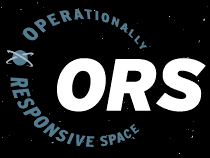 The Joint Operationally Responsive Space (ORS) program was established on 21 May 2007 and is tasked to design and develop low-cost, rapid-reaction payloads, buses, space lift and launch-control methods to meet joint military operational requirements for on-demand space support and regeneration. It focuses on providing quick-response tactical space-based capabilities to the warfighter utilizing smaller satellites, such as the Tactical Satellite Program (Tac-Sat) and smaller launch vehicles. The ORS Program Management Office (PMO) is located at Kirtland AFB and is part of the Air Force’s Space and Missile Systems Center (SMC).
The Joint Operationally Responsive Space (ORS) program was established on 21 May 2007 and is tasked to design and develop low-cost, rapid-reaction payloads, buses, space lift and launch-control methods to meet joint military operational requirements for on-demand space support and regeneration. It focuses on providing quick-response tactical space-based capabilities to the warfighter utilizing smaller satellites, such as the Tactical Satellite Program (Tac-Sat) and smaller launch vehicles. The ORS Program Management Office (PMO) is located at Kirtland AFB and is part of the Air Force’s Space and Missile Systems Center (SMC).
Website: DISA Operationally Responsive Space (ORS)
There are three (3) tiers that are associated with the ORS program:
- Tier-1: uses existing or on-station capabilities to provide highly responsive space effects through the employment/modification of existing, fielded space capabilities. The targeted time period for Tier-1 solutions is minutes to hours from the time at which the need is established. These solutions focus on existing ground and space systems, operations and processes. Although mission or system utilization analyses may be needed, Tier-1 solutions will not typically involve the design, engineering, or fabrication of new material items.
- Tier-2: solution will be considered when a Tier-1 solution cannot respond to the need. Tier-2 solutions will utilize field-ready capabilities or deploy new or additional capabilities that are field ready. The targeted timeframe for delivering usable Tier-2 solutions is days to weeks from the time at which the JFC need is established. The focus of activities in Tier-2 solutions is on achieving responsive exploitation, augmentation, or reconstitution of space force enhancement or space control capabilities through rapid assembly, integration, testing, and deployment of a small, low cost satellite.
- Tier-3: In some cases, an expressed need may not be addressable through Tier-1 or Tier-2 capabilities. In such cases, ORS will focus on the rapid development and deployment of a new capability. Once developed, Tier-3 capabilities will be responsively deployed and employed in the same way as Tier-2 assets. The goal of executing Tier-3 is months to one year from established need to presentation of operational capability. Achieving such a timeline will be very challenging and cannot be accomplished unless the amount of new development involved is limited. Consequently, much of the work will be anticipatory in nature – identifying the most probable emergent space needs and preparing the elements required to ensure highly responsive delivery of needed capabilities. This anticipatory foundation is critical for realizing the one year goal for providing space capabilities in response to urgent needs.
The Joint ORS Office specific missions include:
- Operationally Responsive Space 4 “Super Strypi – Responsive Small Launch”: The ORS Office with support from the Sandia National Laboratories is developing a small launch vehicle known as Super Strypi. The goal is to deliver payloads in the range of 300kg to Low Earth Orbit (LEO).
- Operationally Responsive Space 3 “The Enable Mission”: The ORS Office is dedicated to building the enabling infrastructure allowing for decreased launch timelines and overall cost savings. The ORS-3 Mission will deliver an Integrated Payload Stack to a 500km, 40.5 degree circular orbit using a Minotaur I launch vehicle (LV). The IPS consists of a larger space vehicle (SV) integrated on CubeStack Wafers that are filled with numerous CubeSats. Once the larger SV has separated, the CubeSats will be deployed in a manner that avoids risk of re-contact. Enabling technologies such as automated LV trajectory targeting and range safety process will be demonstrated.
- Operationally Responsive Space 2 “1st End-to-End Demonstration of rapid assembly, integration, test, & operations”: The ORS Office is fully invested in producing an ORS architecture that is redefining the space enterprise. The end state vision of the ORS Concept consists of reconfigurable, modular systems with standard interfaces that are interoperable with the existing ground systems architecture. The goal is to be able to develop, assemble, integrate, launch and operate “good enough” systems rapidly (less than one year for a new system). This concept will be demonstrated in the ORS-2, Tier-2 Enabler Mission.
- Operationally Responsive Space 1: ORS-1 was initiated at the direction of the Commander, U.S. Strategic Command and the DoD Executive Agent for Space to address a U.S. Central Command (USCENTCOM) need for enhanced battlefield awareness. ORS-1 is the first and only dedicated space intelligence capability for USCENTCOM, introducing Operationally Responsive Space as a new paradigm for the Department of Defense.
AcqLinks and References:
